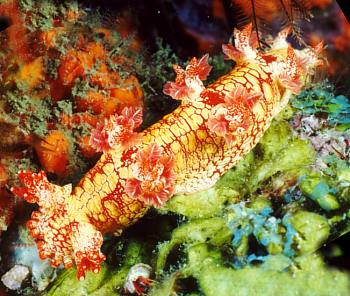
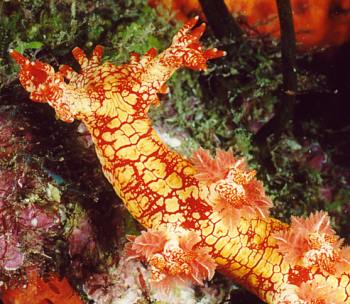
Bornella calcarata
Morch, 1863
Order: NUDIBRANCHIA
Suborder: DENDRONOTINA
Family: Bornellidae
DISTRIBUTION
Caribbean, Brazil.
PHOTO
St. Vincent Island, Caribbean, approx 3 inches. Depth approx 60 feet, August 2002. Photo: Linda Ianniello.
Body translucent to opaque white with a reticulate pattern of orange or orange-red. Similar in shape to other species of the genus ans swims by lateral flexion of the body when disturbed. Grows to at least 50mm long.
Reference:
• Thompson, T.E. (1980) Jamaican Opisthobranch Molluscs II. Journal of Molluscan Studies, 46: 74-99.
Rudman, W.B., 2002 (June 15) Bornella calcarata Morch, 1863. [In] Sea Slug Forum. Australian Museum, Sydney. Available from http://www.seaslugforum.net/find/borncalc
Related messages
Bornella calcarata from Utila, Honduras
December 15, 2008
From: Julio A. Gutierrez
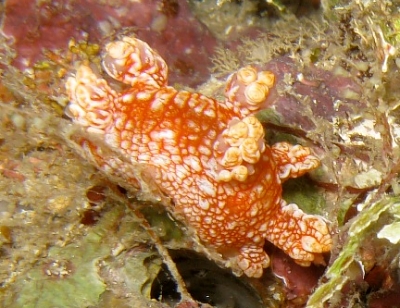
Concerning message #22084:
I found this Bornella calcarata at the divesite known as Black Coral Wall during a night dive. I asked David Pieribone to take a picture of it so I could look it up.
Locality: Black Coral Wall, Utila, Bay Islands, 40 feet, Honduras, Caribbean, November 26, 2008, on a wall as seen in pic. Length: 2.5 inches. Photographer: David Pieribone.
Julio Gutierrez
julio_gutierrez@yahoo.com
Gutierrez J.A., 2008 (Dec 15) Bornella calcarata from Utila, Honduras. [Message in] Sea Slug Forum. Australian Museum, Sydney. Available from http://www.seaslugforum.net/find/22090Thanks Julio,
It's good to get records of this rarely reported species
Best wishes,
Bill Rudman
Bornella calcarata from - Grand Turk Is., Caribbean
September 15, 2007
From: Janet Molchan
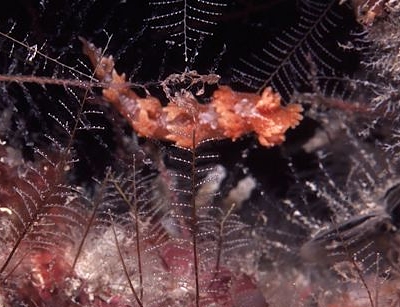
I would like to know the species of nudibranch in the attached photo.
Locality: Grand Turk, Turks and Caicos, Atlantic Ocean, 25 April 1999, Wall dive at Library reef. Length: approx 2 inches. Photographer: Janet Molchan.
Thanks!
Janet
jmolchan@bellsouth.net
Molchan, J. E., 2007 (Sep 15) Bornella calcarata from - Grand Turk Is., Caribbean. [Message in] Sea Slug Forum. Australian Museum, Sydney. Available from http://www.seaslugforum.net/find/20728Dear Janet,
I can't see the animal too clearly, but from the general shape I am pretty sure it is Bornella calcarata.
Best wishes,
Bill Rudman
Bornella calcarata from Utila, Honduras
December 1, 2005
From: Les Wilk
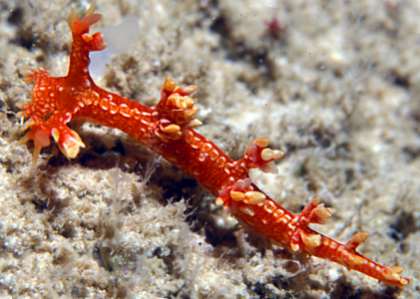
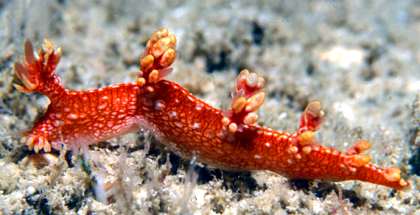
Hi Bill;
Here's a Bornella calcarata from a cave in Utila (Honduras). So far, the only one we've encountered.
Locality: Utila, Honduras, Caribbean . Depth: 30 feet. Length: 1 inch. July 2000. cave, rocky/fibrous bottom. Photographer: Keri Wilk
Keri Wilk
wilk@reefnet.ca
Wilk, L., 2005 (Dec 1) Bornella calcarata from Utila, Honduras. [Message in] Sea Slug Forum. Australian Museum, Sydney. Available from http://www.seaslugforum.net/find/15366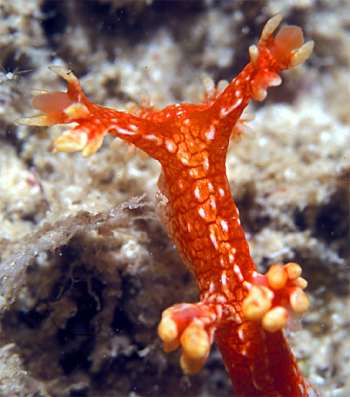
Dear Les,
I guess all the animals I have as Bornella calcarata on the Forum are the same species. They certainly show quite a variation in colour pattern but there seem to be traces of a white or yellow median line down the dorsum which forks out onto the rhinophores in all the photos. One thing your animal lacks though, are the numerous gills on each ceras so visible in the other photos. Perhaps your animal was feeling nervous and had them contracted?Best wishes,
Bill Rudman
A Bornella from the Bahamas?
October 16, 2002
From: Bob Fenner
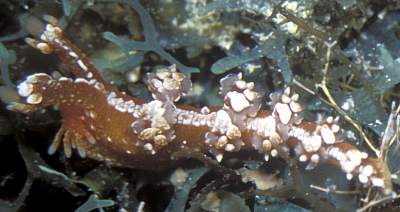
Can you help me identify with this photo? I have others. Shot in thirty feet of water in the Bahamas.
Bob Fenner
bobfenner@wetwebmedia.com
Fenner, R., 2002 (Oct 16) A Bornella from the Bahamas?. [Message in] Sea Slug Forum. Australian Museum, Sydney. Available from http://www.seaslugforum.net/find/8163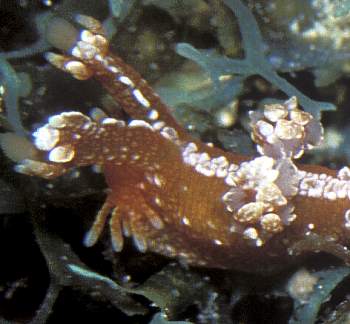
Dear Bob,
This is indeed a species of Bornella. Fortunately, only one has been described from the Caribbean region so I can pretty confidently identify it as Bornella calcarata. Have a look at the other photos and messages on this page to see the variation in colour of this species. It seems the broad white band down the dorsal midline is present in some form. The fingerlike 'oral veil' on either side of the mouth is very characteristic of the genus.
Best wishes,
Bill Rudman
Bornella calcarata from St. Vincent Is.
September 24, 2002
From: Linda Ianniello

Dear Bill,
Attached is a photo of what matches the Bornella calcarata in Paul Humann's book. However, it is not at all like the specimen listed on the Forum. I have photographed it in Belize and Grand Turk and it was small, about 1.5 inches as described in Paul's book. However, this one from St. Vincent Island, Caribbean, was twice that size, a good 3 inches. It was found at night at a depth of about 60 feet, in August 2002. I also attached a close-up of the interesting shape of the head, and the gills along the side. Regards,
Linda I.
lindai@us.ibm.com
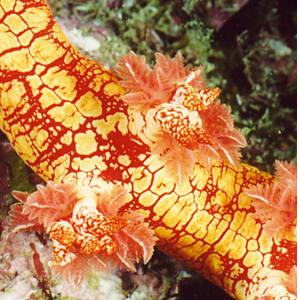
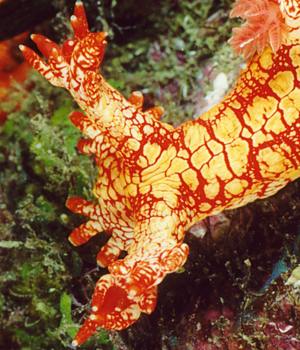

Dear Linda,
Thanks for these photos which I am sure are of Bornella calcarata. The specimen from Colombia, already on the Forum, is a preserved animal which has lost its colour in preservative. It has also lost the finer details of its living shape. That is why I have often commented that it is not a good idea to describe new species from preserved animals - they often a little resmblance to the living thing.
Best wishes,
Bill Rudman
Bornella from Colombia
June 17, 2002
From: Alexander Taborda M.
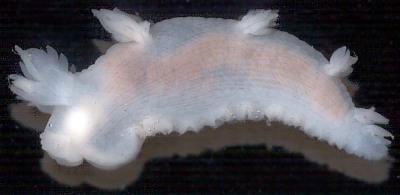
Dear Dr. Rudman,
Could you please help me with the identification of this organism. Is it Hancockia sp.? It was collected at 20 metres depth in a bottom trawl in Santa Marta (Colombia - Caribbean). Length 3cm.
Thanks for your collaboration.
Alexander Taborda M.
alexandertaborda@hotmail.com
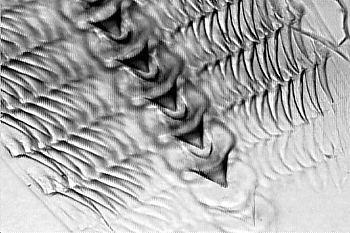
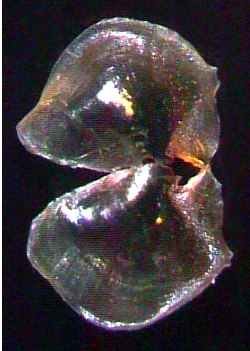
Dear Alexander,
From the shape of the animal, and the radula, this is a species of Bornella. The only species reported from the Caribbean is Bornella calcarata so that is the most likely identification.
Although Hancockia is somewhat similar in external shape, the dorsolateral processes are not stalked cerata like in Bornella, and the radula is triseriate - that is it has a central tooth and only one lateral tooth on each side.
Cheers,
Bill Rudman
